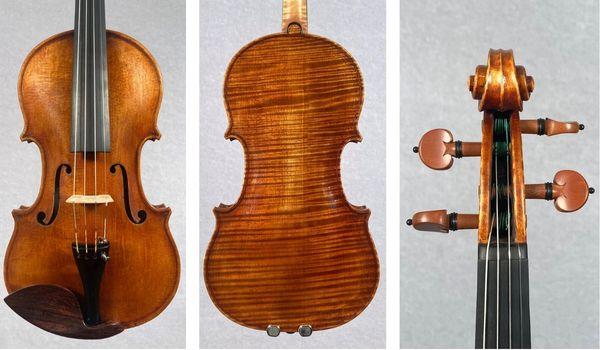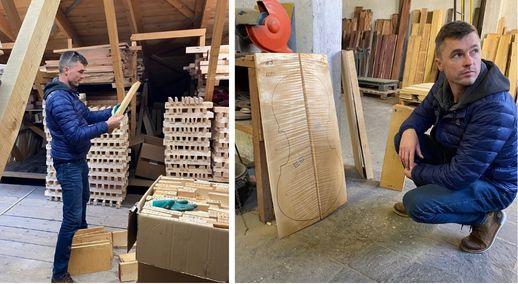 Doug Coghill (alum 2011, viola) never dreamed that his career would take the path it has. Violist with the Tasmanian Symphony Orchestra since 2016, Doug has now found what he believes is his calling – as a luthier and string instrument procurer.
Doug Coghill (alum 2011, viola) never dreamed that his career would take the path it has. Violist with the Tasmanian Symphony Orchestra since 2016, Doug has now found what he believes is his calling – as a luthier and string instrument procurer.
Though oboists are known for making their own reeds and percussionists are skilled in creating instruments out of any object they can find, string players aren’t the usual culprits for making their own instruments. Doug tells us how his grandfather, the late Don Fairweather, influenced his turn to the craft. Don was a mining engineer in Broken Hill, but held a love of music and was an amateur viola player. With his wife, Don hosted many artists touring to Broken Hill with Musica Viva in their home. He wasn’t a particularly religious man, but Don felt a deep spiritual connection to music. Doug fondly remembers spending many hours of his childhood with his grandfather listening to records of Beethoven and Mozart string quartets, reading the score together as they listened.
When Don retired from mining in the mid-1980s, he took up woodworking. Reading all he could about making string instruments, Don began to make his own. He shared with Doug a passion for manipulating wood to make instruments with the best sound possible.
During his teens, Doug made his first instrument with his grandfather: a viola. It took several years, and when completed in 2005, Doug submitted it as his Year 12 final woodworking project. Looking back, Doug says that though this instrument wasn’t particularly good, this special time creating his first instrument together cemented his close bond with his grandfather. Don passed away just a year after the viola was completed.
 A violin made by Doug Coghill in 2024, based on a 1770 instrument by Nicolò Gagliano
A violin made by Doug Coghill in 2024, based on a 1770 instrument by Nicolò Gagliano
After finishing school, Doug focused on his viola performance, studying music at the Victorian College of the Arts (2006-2008) and the Australian National Academy of Music (2009-2011). Doug is still heavily influenced by his time at ANAM, crediting it with shaping him into the musician he is today. Each week he was inspired by amazing faculty – including many who still teach at ANAM, such as Timothy Young, Howard Penny, and Adam Chalabi. Doug recalls his viola teacher Bill Hennessy (teaching viola as well as violin at the time) priming not just his viola technique, but also his psychological preparation to achieve his best.
Doug admits that he was never the strongest player, but was always willing to “give music a shot”. He fondly remembers competing with Thibaud Pavlovic-Hobba (alum 2012, violin) to perform at as many String Classes and Fora (now known as Performance Classes) as he could. “Looking back, I feel sorry for my colleagues who had to put with me almost every week, playing anything including my orchestral excerpts!” But this gave Doug the confidence to perform in a way that studying at university never could. More treasured memories and learning experiences came in the form of the “incredible” chamber music opportunities ANAM provides, where Doug was able to perform alongside world-class musicians including Alban Gerhardt, Michael Collins and Anthony Marwood. Of these opportunities, Doug says that “it truly helped me grow as a musician.”
 Doug couldn’t believe his good fortune stumbling across this original Guadagnini viola whilst touring northern Italy with mentor Michael Stürzenhofecker. Only having access to pictures of this storied instrument, Doug had been using it as a model for his own violas.
Doug couldn’t believe his good fortune stumbling across this original Guadagnini viola whilst touring northern Italy with mentor Michael Stürzenhofecker. Only having access to pictures of this storied instrument, Doug had been using it as a model for his own violas.
Upon completing his time at ANAM, Doug moved to Hobart to take up casual work with the Tasmanian Symphony Orchestra, and later obtained a permanent position with the TSO in 2016. It was around this time, as Doug settled into this role, that the idea of making instruments resurfaced again. Setting himself up in a house with a workshop space, Doug began to reignite the flame that was lit by his grandfather many years before.
Doug visited Europe and met with fellow instrument makers – as you would expect, luthiers are a small community – with some more willing than others to part with their knowledge and ‘trade secrets’. When Doug met with German luthier Michael Stürzenhofecker, he was struck by Michael’s generosity to share his expertise. “He really took me under his wing. When we first met, I literally just asked him questions non-stop for three days. He was incredibly patient and generous with his time and knowledge.” Doug and Michael have since struck a friendship as well as a mentorship, with Doug returning to visit Europe regularly to source woods, and observe the instrument-making process. Doug and Michael will make their first instrument together later this year.
In Hobart, Doug has established Coghill String Instruments, where he not only sells his own instruments, but also buys and sells quality European instruments both modern and historic. He is particularly passionate about “instrument networking”: matching the right instrument and the right bow with the right musician. Doug explains that “it’s so difficult to get good bows here in Australia, and I’m hoping to change that!”. This instrument networking is not just about getting the right instrument to the musician, but requires careful setting up to achieve its optimal sound. Doug considers the instrument’s purpose, as string instruments can be set up differently for solo, chamber or orchestral settings, and fine-tuning chin and shoulder rests to ergonomically fit the physique of the musician.
Increasingly, he is asked not just by students, but professional musicians, to adjust their setups to reduce fatigue and injury. Doug reveals, “being a working musician for many years myself, I have first-hand experience of what’s required to prevent injury. I not only help with adjustments, but also empower musicians to make these small adjustments on their instrument themselves, when required.” Tweaking a bridge or soundpost can invoke terror even amongst seasoned professionals, but when done safely and with knowledge, this can make a significant difference to the sound of an instrument and can improve the ease of playing the instrument for the musician.
 Doug selecting fine tonewood for instrument making at Bachmann, in the South Tyrol province of Italy, near the Italian-Austrian border.
Doug selecting fine tonewood for instrument making at Bachmann, in the South Tyrol province of Italy, near the Italian-Austrian border.
By late 2023 Doug found himself burning out, juggling his instrument-making and the business alongside his work at the TSO. He approached orchestral management and was offered a reduction to part-time, working just half of his previous load. “They were so supportive, and could see the value in what I am doing. I feel so fortunate – I get to improve and grow as a luthier, as well as continue working as an orchestral and chamber musician with the TSO. Plus, more casuals are getting work now…it’s a win-win.” Doug appreciates that this part-time arrangement isn’t too common in the industry, and hopes that flexible working arrangements for orchestral musicians can be more widely accepted. “I’m sure there’s a need out there, not just for musicians working on other projects like myself, but especially for parents with young kids, or musicians with family caring responsibilities.”
So, what’s next for Doug and Coghill String Instruments? Doug recently purchased a van, which is nothing special to look at, but Doug is brimming with excitement of the possibilities this vehicle provides. It will allow him to tour the island and provide a mobile service for instrument repairs and maintenance, something that is severely lacking for regional communities outside of Hobart. It also allows for Doug to visit the mainland, deliver commissioned instruments, and connect with musicians and string pedagogues across the country. Doug also aspires to enter his instruments into luthier competitions over the next few years (yes, it’s a thing), and if successful, will put the quality of his instruments on the world stage.
For more information visit coghillstringinstruments.com
Words by Laura Panther
Photo credits: Doug Coghill